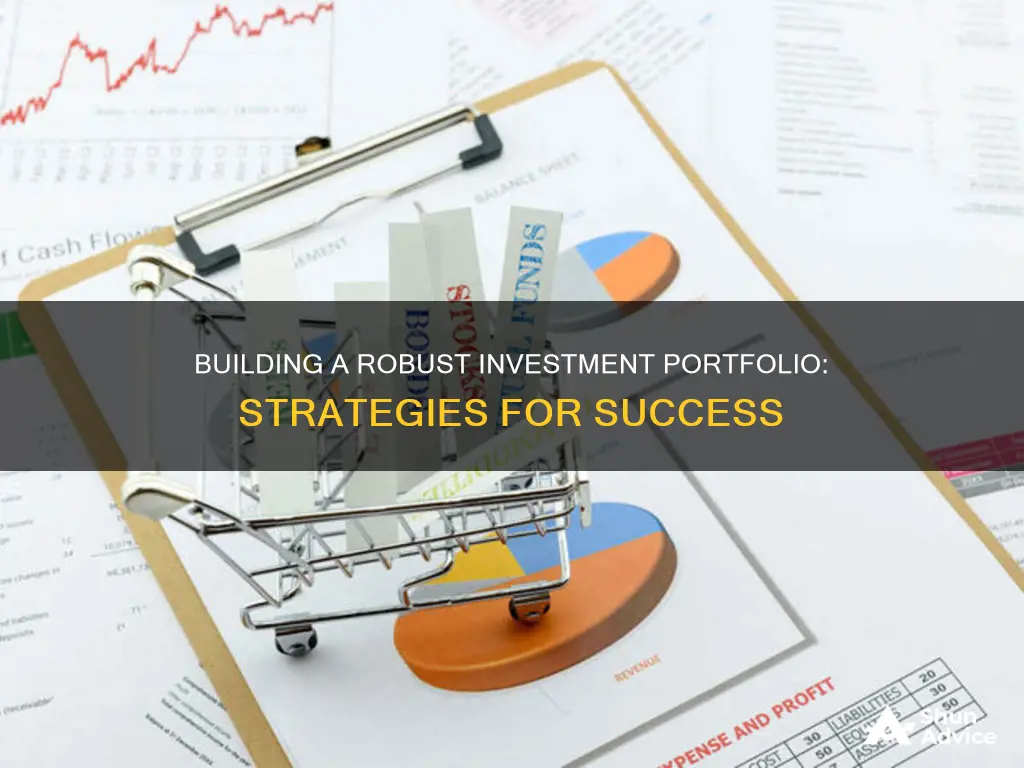
Building an investment portfolio can be a challenging task, but it is a crucial step towards achieving your financial goals. A well-diversified portfolio is vital for the consistent long-term growth of your investments. The first step is to determine your financial goals and risk tolerance. This will help you decide on an optimal portfolio mix, including the types of assets you want to invest in and the level of risk you are comfortable with. You should also consider your investment time horizon, or how long you plan to hold your investments. Once you have a clear understanding of your goals and risk tolerance, you can start selecting specific investments that align with your strategy. It is important to regularly monitor and rebalance your portfolio to ensure it stays on track and adjust it as your goals and circumstances change.
| Characteristics | Values |
|---|---|
| First step | Determine your goals and time horizon |
| Second step | Understand your risk tolerance |
| Third step | Choose an account type that aligns with your goals |
| Fourth step | Select your investments |
| Fifth step | Create your asset allocation and diversify |
| Sixth step | Monitor, rebalance and adjust |
What You'll Learn

Define your goals and risk tolerance
Defining your goals and risk tolerance is a crucial step in building an investment portfolio. Here are some detailed instructions to help you through this process:
Identify your goals:
Start by making a list of your financial goals. These could include saving for retirement, buying a new car, investing for a child's education, or purchasing a home. Each goal will have a different time horizon, which is how long you need to hold the investments before you need the money. For example, short-term goals are those where you need the money within a year, medium-term goals take one to five years, and long-term goals are those that take more than five years to achieve.
Understand your risk tolerance:
Your risk tolerance is your ability to handle potential losses in the pursuit of higher investment returns. It's important to be honest with yourself about how much risk you're comfortable with. Consider how you would react if the market went down and your account value dropped. Could you tolerate short-term losses in exchange for potentially higher returns? Your risk tolerance will help determine the level of aggressiveness in your investment strategy.
Match your goals and risk tolerance:
Once you know your goals and risk tolerance, you can match them to determine your investment approach. If you have a long time horizon and a higher risk tolerance, you may be able to take on more aggressive investments with the potential for higher returns. On the other hand, if you have short-term goals or a lower risk tolerance, a more conservative strategy with less volatile investments may be more suitable.
Review and adjust:
Remember that your goals and risk tolerance may change over time. Regularly review your investment portfolio to ensure it still aligns with your current situation and needs. For example, as you get closer to retirement, you may need to adjust your portfolio to focus more on conservative investments to protect your assets. Similarly, if your risk tolerance changes, you may need to reevaluate your investment strategy.
By clearly defining your goals and understanding your risk tolerance, you can make more informed decisions about your investment portfolio and choose investments that align with your objectives and comfort level.
Invest Your Savings: Safe Strategies for Beginners
You may want to see also

Choose an account type
Choosing the right type of account is an important step in building an investment portfolio. There are several different types of investment accounts, each with its own advantages and considerations. Here are some key points to consider when selecting the right account type:
- Tax-Advantaged Accounts: These accounts, such as Individual Retirement Accounts (IRAs) and 401(k) plans, offer tax benefits for long-term retirement goals. They can accommodate various risk tolerance levels and are an excellent option for those looking to save for retirement.
- Taxable Brokerage Accounts: These accounts are suitable for mid- to long-term goals where you seek more upside potential than a lower-risk deposit account. They are often used for non-retirement goals, such as saving for a down payment on a house.
- Deposit Accounts: This category includes Certificates of Deposit (CDs), money market accounts, and high-yield savings accounts. These accounts are ideal for short-term goals where capital preservation and modest growth are prioritised over higher returns.
- Robo-Advisor Accounts: If you prefer a hands-off approach to portfolio management, robo-advisors can build and manage your investment portfolio based on your risk tolerance and goals. They are a cost-effective alternative to traditional financial advisors.
- Financial Advisor Accounts: For comprehensive financial planning and investment management, you may consider working with a financial advisor. They can help you build a portfolio aligned with your goals and provide additional services such as retirement planning and estate planning.
- Brokerage Accounts: To start investing, you will need a brokerage account if you don't already have one. Brokerage accounts allow you to buy and sell various financial instruments, such as stocks, bonds, mutual funds, and exchange-traded funds (ETFs).
It's important to note that your choice of account type may depend on your specific goals, time horizon, and risk tolerance. Additionally, it's worth considering the tax implications of each account type to optimise your investment strategy.
Savings Surplus: Impact on Economy and Investment Opportunities
You may want to see also

Pick investments
Picking Investments
Once you have established your investment profile, asset allocation, and diversification, it's time to select your investments.
For your stock bucket, you can choose individual shares, mutual funds, or exchange-traded funds (ETFs). If you opt for individual stocks, you will need to research each company, including its sales, profits, market share, management, and competition within its industry.
If you go for mutual funds or ETFs, you will need to decide whether to use actively or passively managed funds. Actively managed funds involve fund managers picking investments they hope will perform better than average, with the goal of outperforming a market benchmark. Passively managed funds, or index funds, aim to match the performance of a benchmark index.
You can also invest in bonds, either by buying individual government, corporate, or municipal bonds, or by investing in mutual funds containing bonds, which can be actively or passively managed.
Other investments to consider include commodities, precious metals, and real estate, which can add diversification to your portfolio as they sometimes outperform stocks. However, these can be notably risky by themselves, so it is recommended to keep stakes small.
You should also consider tax efficiency when selecting investments. Tax-inefficient investments, such as taxable bonds, real estate investment trusts, and actively managed stock mutual funds, are best held in tax-deferred accounts. Tax-efficient investments, such as index stock mutual funds, exchange-traded index funds, tax-managed stock funds, and individual stocks, can be held in taxable accounts.
Finally, remember that you don't need to be wealthy to succeed at portfolio investment. You can start by investing in companies you already know and like, or those that play a role in your life. This will help you invest more confidently as you will already understand these brands.
Demand-Supply Equilibrium: Savings, Investments Balance
You may want to see also

Diversify your portfolio
Diversifying your portfolio is a crucial step in building an investment portfolio. Diversification is an important tool to balance growth and risk. The basic objective of diversification is to reduce risk. The saying goes, "Don't put all your eggs in one basket." Diversification helps to restrict the damage to your financial well-being in case one asset class or instrument takes a turn for the worse.
Diversify Across Asset Classes:
- Invest in a range of asset classes such as stocks, bonds, cash, real estate, cryptocurrencies, and precious metals.
- Within stocks, consider large, small, and mid-cap stocks, growth and value styles, and domestic and international stocks, including emerging markets.
- There are different types of bonds, such as short-term and long-term, government and corporate debt.
Diversify Across Industries and Sectors:
The performance of stocks can be influenced by the industries and sectors they belong to. For example, factors impacting stocks in the technology sector may be different from those in the energy sector.
Diversify Across Bond Types:
- Bond prices usually move inversely to interest rates. When interest rates rise, bond prices tend to fall, and vice versa.
- Factors affecting bond prices include the time to maturity, credit quality of the issuer, and the rate of exchange for bonds issued outside the US.
Diversify Using Mutual Funds and ETFs:
- Mutual funds and exchange-traded funds (ETFs) offer diversification by investing in a specific asset class or a mix of asset classes.
- They provide exposure to a variety of stocks, bonds, or other securities, offering another level of diversification.
- These funds can be cost-effective for investors who may not have a large amount to invest.
Consider Alternative Investments:
You can also invest in alternative assets such as precious metals (e.g., gold), real estate, cryptocurrencies, hedge funds, and commodities.
Monitor and Rebalance:
- Regularly monitor your portfolio to ensure it aligns with your goals and risk tolerance.
- Rebalance your portfolio periodically to restore its original makeup. This may involve selling overweighted securities and buying underweighted ones.
Remember, diversification does not eliminate investment risk, but it helps to manage it. The level of diversification and the specific assets you choose should be based on your financial goals, risk tolerance, and investment horizon.
Investing Savings Wisely: Your Path to Home Ownership
You may want to see also

Monitor and adjust
Monitoring and adjusting your investment portfolio is an important step in ensuring your portfolio remains aligned with your goals and risk tolerance. Here are some detailed instructions on how to monitor and adjust your investment portfolio:
Regularly Review Your Portfolio:
Life and financial markets are ever-changing, so it's crucial to review your portfolio regularly. This could mean checking in on your portfolio at least once a year and possibly more often if your personal circumstances change or market conditions become volatile. During your review, assess whether your investment mix still aligns with your goals and risk tolerance.
Rebalance Your Portfolio:
Over time, the performance of different investments within your portfolio can cause your initial weightings to change. For example, if one of your stocks experiences significant growth, it may throw off the proportions of your portfolio. Rebalancing involves buying or selling certain investments to return your portfolio to its intended asset allocation. This can be done manually or through a robo-advisor, which can automatically rebalance your portfolio for you.
Adjust for Life Changes:
Major life changes, such as getting married, having children, receiving an inheritance, or nearing retirement, may require you to adjust your investment strategy. Re-evaluate your goals, time horizon, and risk tolerance in light of these life changes and make adjustments to your portfolio as needed.
When rebalancing your portfolio, consider the tax implications of selling certain assets. For example, selling appreciated assets may trigger capital gains taxes. In some cases, it may be more beneficial to stop contributing to a specific asset class rather than incurring immediate tax consequences. Additionally, consider the tax efficiency of different types of investments and hold tax-inefficient investments in tax-deferred accounts, while holding tax-efficient investments in taxable accounts.
Stay Diversified:
Diversification is key to managing risk and maintaining a well-balanced portfolio. Periodically assess the diversification of your portfolio across different asset classes, sectors, and industries. Make adjustments as needed to ensure your portfolio remains diversified, reducing the impact of market fluctuations on your overall portfolio.
Savings and Investments: Your Guide to Financial Freedom
You may want to see also







